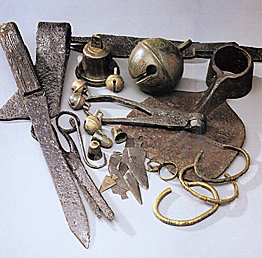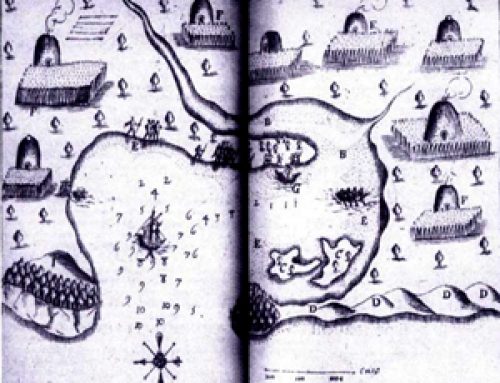
European trade goods (thanks to Nebraska Game and Parks Division)
North American people made rapid scientific advances in the course of the 1500s AD, inspired by contacts with traders and explorers from Europe. People learned how to tame horses and ride them, and they learned how to use guns. They also began to use a lot more iron knives and tools than they had before, and learned how to make good iron themselves.
At first these new ideas were mainly known to people like the Cherokee and Pueblo who lived near the European explorers, along the Atlantic coast and in the Southwest. But in the 1600s and 1700s AD these people taught the new ideas to their neighbors, and soon people who had never seen anyone from Europe had also learned to use guns and ride horses.

Settlers using a canoe, from Manitoba, 1824 AD
At the same time, people from Europe who came to live in North America were learning North American scientific discoveries. They learned how to farm corn and squash, sweet potatoes and sunflowers, and how to use fish for fertilizer. They also learned to make canoes and kayaks, which were very useful to them. Both groups of people learned to use each others’ herbal medicines, though most of these medicines were pretty useless anyway.
People from Africa, who came to North America as slaves, also brought with them new knowledge, like the best ways to grow rice and cotton, which became the most important crops of the southern part of North America. An African man, Onesimus, also brought knowledge of how to inoculate people against smallpox.
At the very end of the 1700s, Eli Whitney improved the cotton gin, which made growing cotton even more important, and helped create the slave economy in the South. Vaccinations also ended smallpox.
In the 1800s, people living in North America learned to use many new inventions from Europe, like big canals, and railroad trains, and better guns. Cholera epidemics starting in 1827 convinced people to build good sewage systems and water systems for big cities, and to arrange for garbage disposal. This ended cholera and dysentery in the United States and Canada. Photography also came to North America from Europe at this time. But some major inventions were made in North America – Samuel Morse developed the telegraph in 1838, and Alexander Graham Bell invented the telephone in 1876.
The 1900s saw many new inventions in North America. Most of them fall into four main kinds:
- the development of oil and different ways to use oil, like machinery, fertilizer, pesticides, and plastic
- the use of electricity, wires, and waves, like electric lights, radio, television, and the Internet
- the development of medical techniques and medicines, like antibiotics, vaccines, and anesthetics, and work with DNA
- the use of radioactivity, as in nuclear power, x-rays, and nuclear bombs




